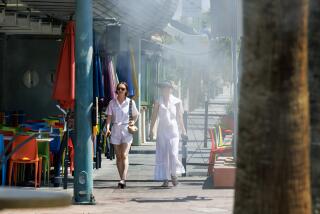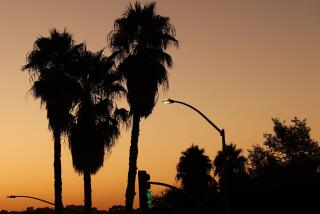It’s the Heat <i> and </i> the Humidity : Weather: A tropical depression combines with high temperatures to make the Southland uncomfortable. Expect more of the same.
- Share via
Heat, smog and a confederate called Fausto mugged Southern California on Wednesday--an assault that forecasters say could continue for a while.
Hurricane-turned-tropical-depression Fausto, centered in the Pacific off Mexico, sent a wave of moisture into the Los Angeles area during the afternoon, bringing a smattering of raindrops and rainbows and making Wednesday’s 90-degree-plus weather feel even hotter than the thermometer’s reading.
The mercury peaked at 96 degrees at the Civic Center--one degree cooler than the record for the date set in 1959--while soaring to 104 in Ontario and 110 in some desert areas, the National Weather Service said.
Wednesday’s minimum temperature of 75 at the Civic Center broke by one degree the record for the highest minimum for the date, also set in 1959, the Weather Service said.
Fausto’s wet fringes pushed humidity levels up--to as high as 62% at the Civic Center--throughout much of the region, and brought light rain near Bakersfield and at points across the Mojave Desert.
The conditions are expected to continue for at least a few more days, forecasters said, as high pressure continues to dominate over the western part of the nation and Fausto continues to break up in the Pacific.
Meanwhile, ozone levels soared, with several monitoring stations recording “unhealthful” smog levels exceeding 100 on the pollution standard index, officials of the South Coast Air Quality Management District said.
A first-stage alert was declared in the Glendora area, where the ozone level reached 205 and air was described as “very unhealthful.”
Similar alerts are predicted for today in parts of Los Angeles, Riverside and San Bernardino counties, said Sylvia Haskell, a spokeswoman for AQMD. She said smog forecasters had predicted higher ozone levels for Wednesday, but the heat served to weaken an inversion layer, allowing pollutants to escape.
High humidity limits the body’s ability to cool itself because perspiration evaporates more slowly, explained meteorologist Bill Hibbard of WeatherData Inc., which supplies weather forecasts to The Times.
“You’re not able to evaporate your perspiration as readily and heat builds up. So you feel hot,” he said.
Not one for cliches, Hibbard says both the heat and humidity are to blame for discomfort. Mostly the heat, in fact. At noon at the Civic Center, for example, the mercury reached 93 degrees, but with humidity at 33%, it felt more like 95 degrees, according to the heat index.
“Anyone who has the opportunity, go to the beach,” Hibbard recommended, explaining that temperatures along the coast are expected to remain as much as 20 degrees cooler.
Hibbard did not recommend a visit there, but Newhall, at least on Wednesday, was one refreshingly dry exception to the muggy weather. The Santa Clarita Valley community registered a relative humidity of 16%. The temperature there at noon was 102 degrees.
But it was so dry, Hibbard said, it felt like only 99.
More to Read
Sign up for Essential California
The most important California stories and recommendations in your inbox every morning.
You may occasionally receive promotional content from the Los Angeles Times.










